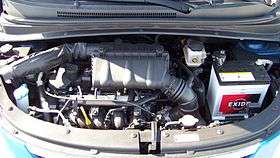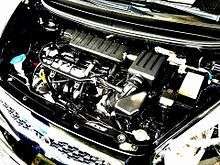Hyundai Kappa engine
Hyundai's Kappa automobile engine series consists of three-cylinder[1] and four-cylinder models.[2]
| κ engine | |
|---|---|
 2009 Hyundai i10 1.25-litre Kappa engine | |
| Overview | |
| Manufacturer | Hyundai Motor Company |
| Production |
|
| Layout | |
| Configuration | |
| Displacement | 1.0 L (998 cc) 1.2 L (1,197 cc) 1.2 L (1,248 cc) 1.4 L (1,353 cc) 1.4 L (1,397 cc) 1.6 L (1,579 cc) |
| Cylinder bore | 71 mm (2.8 in) 72 mm (2.83 in) |
| Piston stroke | 75.6 mm (2.98 in) 78.8 mm (3.10 in) 84 mm (3.31 in) 97 mm (3.82 in) |
| Block material | Aluminium |
| Head material | Aluminium |
| Valvetrain | DOHC 4 valves x cyl. with VVT |
| Combustion | |
| Turbocharger |
|
| Fuel system | Direct injection |
| Fuel type | Gasoline |
| Cooling system | Water-cooled |
| Output | |
| Power output | 68–140 hp (51–104 kW; 69–142 PS) |
| Torque output | 82–178 lb⋅ft (111–241 N⋅m) |
| Dimensions | |
| Dry weight | 71.4–84 kg (157–185 lb) |
| Chronology | |
| Predecessor | Epsilon |
Kappa
- 1.2 L
The 1.2 L (1,197 cc)-litre variant is gasoline powered, all-aluminum, and utilizes a DOHC 16-valve design, as opposed to the SOHC 12-valve design of its predecessor, the Hyundai Epsilon engine. 76 hp (57 kW; 77 PS) at 5,200 rpm and 82 lb⋅ft (111 N⋅m) of torque at 4,000 rpm.
- 1.25 L
The 1.2 L-litre is the European version displacing 1,248 cc (1.25 L). It makes 78 hp (58 kW; 79 PS) at 6,000 rpm and 87 lb⋅ft (118 N⋅m) of torque at 4,000 rpm. Actual output figures may slightly vary from market to market. Fuel economy is rated at 5 L/100 km (47 mpg‑US; 56 mpg‑imp) in the European combined test cycle.
Kappa II MPi

Main improvement is adding VVT (Variable valve timing) to the engine.
- 1.0 L
The 1.0 L (998 cc)-litre three-cylinder engine makes 68 hp (51 kW; 69 PS) at 6,200 rpm and 70 lb⋅ft (95 N⋅m) of torque at 3,500 rpm.
- 1.25 L
Hyundai engineers have taken the existing 1.25 L (1,248 cc) 4-cylinder Kappa engine and added VTVT (Variable Timing and Valve Train), which now makes 86 hp (64 kW; 87 PS) at 6,000 rpm and 90 lb⋅ft (122 N⋅m) of torque at 4,000 rpm.
- 1.4 L
The 1.4 L (1,353 cc)-liter Dual-CVVT engine makes 94 hp (70 kW; 95 PS) at 6,000 rpm and 95 lb⋅ft (129 N⋅m) of torque at 4,000 rpm.
Kappa II GDi
- 1.0 T-GDi
The 1.0 L (998 cc)-litre turbocharged three-cylinder engine makes 120 PS (118 hp; 88 kW) at 6,000 rpm and 17.5 kg⋅m (172 N⋅m; 127 lbf⋅ft) of torque between 1,500 and 4,000 rpm. A detuned version that makes 100 PS (99 hp; 74 kW) at 6,000 rpm is also available for some applications.
- 1.4 T-GDi
The 1.4 L (1,397 cc)-litre turbocharged four-cylinder engine which was announced in 2015 makes 140 PS (138 hp; 103 kW) at 6,000 rpm and 24.7 kg⋅m (242 N⋅m; 179 lbf⋅ft) of torque between 1,500 and 3,200 rpm. A detuned version which produces 128 hp (95 kW; 130 PS) at 5,500 rpm and 156 lb⋅ft (212 N⋅m) of torque at 1,400 rpm is also offered in certain markets, such as the Hyundai Elantra Eco sedan in United States as of 2017.
- 1.6 L
The 1.6 L (1,579 cc)-litre GDI four-cylinder engine makes 104 PS (103 hp; 76 kW) at 5,700 rpm and 15 kg⋅m (147 N⋅m; 108 lbf⋅ft) of torque at 4,000 rpm. In addition, there is an Atkinson cycle version of this engine. This engine is utilized in either the Kia Niro or Hyundai Ioniq as of 2017.
Development
Developed at a cost of $421 million over a period of 48 months, the Kappa project was aimed at increasing fuel economy while ensuring compliance to stringent EURO-4 emission regulations. The newest versions of Kappa engine family comply with Euro-6DTemp regulations.
Design
The engine block is made from high pressure die-cast aluminum which results in considerable weight savings - the entire engine with a manual gearbox only weighs 82.4 kg (182 lb). The main block features a ladder frame construction for structural stiffness while its cylinders are fitted with cast-iron liners for improved abrasion durability. Additional weight was shaved off by integrating the engine support bracket with the timing chain cover. The shape of the piston skirt was optimized to reduce its size while the compression height of the piston was also reduced, resulting in weight savings. The optimized piston skirt is also treated with molybdenum disulfide. A highly sophisticated process of Physical Vapor Deposition (PVD) is used to apply an ultra-thin layer of Chromium nitride to the piston’s oil ring. Chromium Nitride-coated piston rings using PVD is an innovative technology borrowed from the Hyundai Tau engine introduced earlier. Friction between the oil ring and cylinder wall has been further minimized by reducing the oil ring tension. The Kappa engine is the first Hyundai engine to be fitted with an accessory drive belt which does not require a mechanical auto-tensioning adjustment device, reducing the hardware and further lowering weight and cost. Because it is designed to maintain an ideal tension setting, the belt runs quieter and with proper preventative maintenance and care, the belt will last 100,000 mi (160,000 km). For ignition, the Kappa engine uses a new, longer reach spark plug which enabled engineers to enlarge the size of the water jacket to promote more efficient engine cooling around the critically important spark plug and exhaust port area. The long reach spark plug (M12 thread) also enabled engineers to enlarge the valve diameter for increased airflow and combustion efficiency. A lightweight, heat-resistant engineering plastic was used for the intake manifold. The fuel delivery pipe assembly is a returnless type (to eliminate evaporative fuel emissions) and is made of SUS (steel use stainless) with a specially designed inner structure for the reduction of pulsation noise.
Valvetrain
The valvetrain features a number of innovations: friction reducing roller swing arm, hydraulic lash adjusters which ensure proper clearances between the valve stem and roller swing arm, which significantly reduce valve tapping noise. The valve springs feature a beehive shape and smaller retainer. The reduced weight and spring load further help lower friction and improve fuel economy. The valvetrain is driven by a silent-type, maintenance free steel timing chain that replaces a roller-type timing chain: The optimized design greatly reduces impact forces and noise when the gear tooth and chain engage.
Offset crank
Unlike a conventional engine where the centerline of the cylinder bore is in perfect vertical alignment with the rotating axis of the crankshaft, the Kappa’s centerline is offset by a small distance. This offset minimizes the lateral force created by the rotating piston & rod assembly (known, and audible, as "piston slap" at its extreme). The net effect is an improvement in fuel consumption and a reduction in noise, vibration and harshness - it should also help with engine longevity since reduced lateral force will equal reduced bore wear.
Engine management
Engine management is provided by two 16-bit 32 MHz microprocessors which control and monitor ignition timing, idle speed, knocking and emissions.
Applications
References
- "2012 Kia Picanto Brochure" (PDF). Kia Motors Philippines. Archived from the original (PDF) on 2012-06-19. Retrieved 2012-07-28.
- Totally Technical: Hyundai's Kappa Engine Explained